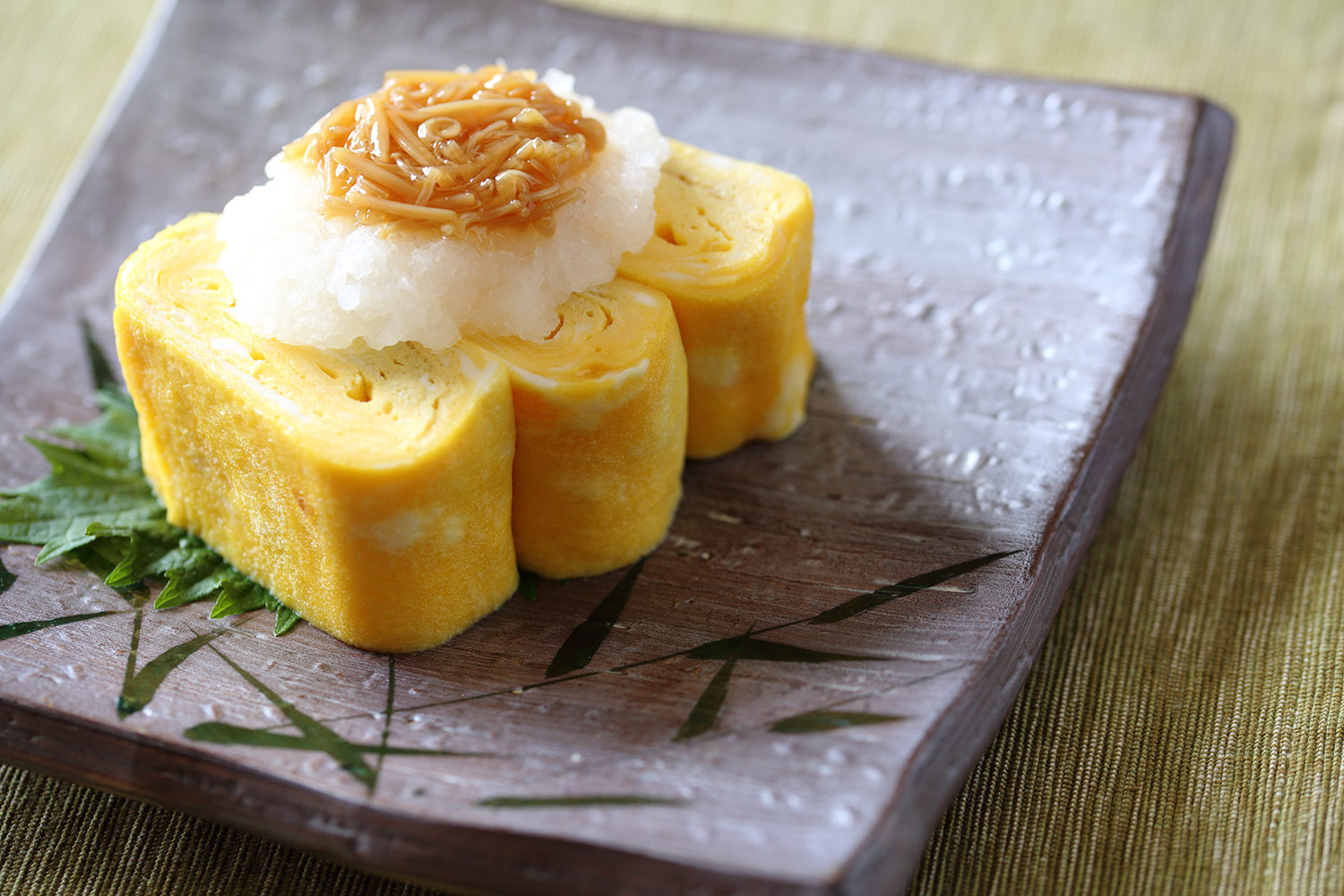

JAPANESE OMELETTE – TAMAGOYAKI (TAMAGO)
Tamagoyaki – Japanese omelette with sushi and more
Ready-to-eat tamagoyaki, meaning simply “grilled egg”, resembles a tightly rolled pancake cut in small slices – similar to sushi slices. Enthusiasts of the light, fluffy texture of tamago also compare it to… puff pastry. This association arises from the layered structure of the Japanese omelettes, which differs the dish from the egg-based dishes we know. The Japanese eat variously seasoned tamagoyaki in the form of a quick, light breakfast or as a side dish with sushi. Chunks of the fluffy omelette are also put in bentos – typical lunch boxes for Japanese students.
Tamago omelette – what is it?
Even though layered omelettes are very popular in Japan, and children always enjoy their sweetish taste, tamagoyaki has not been a part of traditional Japanese cuisine for long. No wonder – there were practically no eggs in the pre-Edo (1603-1868) period on the menu of the Country of Cherry Blossoms. Tamago is also absent in cook books from the mid 18th century, where first recipes using eggs appeared. The reasons for such late introduction of Japanese omelettes are to be sought in the other ingredients of the dish. Sugar and mirin – a sweet liquid spice with 14-percent alcohol content, necessary to keep the omelettes fluffy – were luxury goods, too expensive for the majority of Japanese at that time. This is why the first tamagoyaki in the current shape appeared as late as in the second half of the 19th century.
Sumo, baseball and tamagoyaki
Until World War II, eggs were not affordable enough to allow omelettes to become a regular guest on Japanese tables. This changed in the 1950s, when the Japanese government started to encourage parents to include more protein in the diets of children. The authorities supported also chicken breeding, which gradually reduced the prices of eggs and made them more common in daily cooking. Tamagoyaki quickly became immensely popular – especially with children. In the 1960s they were even referred to as one of the three favourites of little Japanese – next to Taihō (Japanese sumo master) and Kyojin (the Yomiuri Giants baseball team). To this day tamagoyaki are enjoyed by children, who take them to school in carefully packed bentos.
How to make tamagoyaki
Just as any omelette, a tamagoyaki is not complicated to make. Still, its preparation requires certain degree of skill and preferably also a rectangular frying pan. What differs tamago from “our” omelettes is also their shape. The original Japanese dish is made on a square pan, where it is easier to roll particular layers. The egg mass is seasoned with sugar, mirin, oil, soy sauce and salt. It is such combination of spices that gives tamagoyaki its unique sweet and saltish taste. The first layer of the omelette is fried briefly n pre-heated oil, and then – once it is set – rolled up with a spatula and pushed to one side of the pan. Add next portion of eggs by making it go under the pre-fried roll as well. Make sure to hold the pan with your hand the whole time to be able to position it above the heat in a way that will protect the earlier layer from being overly fried. When the next layer starts to set, we push it to wrap the previous one. Keep repeating until the whole egg mass is used. When all the layers are ready, place the rolled omelette on a bamboo sushi mat to form a well formed cylinder. The roll is also sometimes flattened to become rectangular at cross-section.
Nigiri tamago and other tamagoyaki recipes
Mild and universal in taste, tamagoyaki will prove perfect both as lunch for children and as a starter or a side dish to go with Japanese main course or sushi. Nigiri tamago is a popular form of serving tamago, also met in Polish sushi bars. It is a small portion of compact rice covered with a piece of layered omelette and wrapped in a thin strip of nori. Tamagoyaki are also served as a standalone snack, gently sprinkled with soy sauce. Egg omelettes are so popular that they are served in Japan even as sides in … McDonald’s.
So? Do you want to try a fluffy Japanese omelette? You do not have to worry about the special shape of the frying pan – you will successfully fry tamagoyaki also in a traditional round pan. What you will need to make a Japanese omelette:
- 4 large eggs
- 1 teaspoonful soy sauce
- 1 tablespoonful mirin (or sake)
- 1 tablespoonful dashi (optional)
- 2 teaspoonfuls sugar
- ¼ teaspoonful salt
- 1 tablespoonful vegetable oil
Making tamago may seem tedious and complicated but in reality it takes just a few moments. And taking that time to relish the special texture of Japanese omelettes is definitely worth it. Enjoy!























